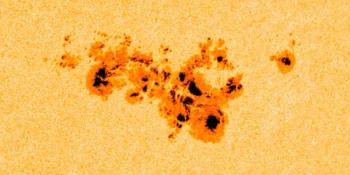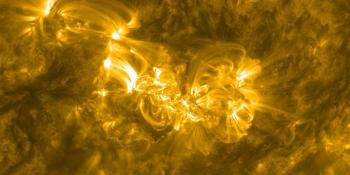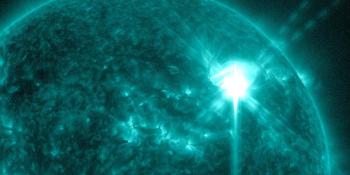Visualizzazione archivio di lunedì, 9 febbraio AM
Rapporto attività solare
Ogni brillamento solare menzionato nel rapporto ha un fattore di scala, applicato dal Centro di Predizione Meteorologica Spaziale (SWPC). A causa del fattore di scala del SWPC, i brillamenti solari sono segnalati come ridotti del 42%, rispetto ai dati di qualità scientifica. Il fattore di scala è stato rimosso dai nostri dati archiviati sui brillamenti solari, per riflettere le unità fisiche reali.
Rapporto dell'Attività Geofisica Solare 2004 Feb 09 2200 UTCPreparati dal SWPC della NOAA© ed elaborati da SpaceWeatherLive.com
Rapporto Congiunto USAF/NOAA dell'Attività Solare e Geofisica
SDF Numero 040 Emesso alle 2200Z il Feb 09 2004IA. Analisi delle Regioni Solari Attive e Attività dalle 2100Z-08 alle 2100Z-09 Solar activity decreased to low levels today. Region
554 (S08E52) produced numerous B and C-class flares today. Ten
C-class flares were recorded with the largest being a C9 x-ray event
that occurred at 09/1102Z. LASCO imagery has shown little, if any
associated CME signatures during the past 24 hours of activity from
this region. Magnetic analysis depicts a delta configuration within
the dominant intermediate spot. Region 551 (S06W27) did not manage
any flare production during the interval, although surging and point
brightenings were observed throughout the period. The gamma
structures in the central and trailing portions of the sunspot group
remain intact. Region 555 (S14E72) was numbered today.
IB. Previsione dell'Attività Solare
Solar activity is expected to be at
low to moderate levels. Regions 551 and 554 both have the potential
to produce M-class flare activity.
IIA. Sommario dell'Attività Geofisica dalle 2100Z-08 alle 2100Z-09
The geomagnetic field was at quiet to unsettled levels. The greater
than 2 MeV electron fluxes at geosynchronous orbit reached high
levels today.
IIB. Previsione dell'Attività Geofisica
The geomagnetic field is
expected to be at quiet to unsettled levels. 12 February may
experience active conditions due to a solar sector boundary
crossing, preceding an anticipated recurrent high speed coronal hole
stream.
III. Probabilità dell'Evento dalle Feb del 10 alle Feb del 12
| Classe M | 50% | 50% | 50% |
| Classe X | 15% | 15% | 15% |
| Protone | 05% | 05% | 05% |
| PCAF | green | ||
IV. Flusso di 10.7 cm di Penticton
Osservato 09 Feb 118 Previsto 10 Feb-12 Feb 120/120/115 Media di 90 Giorni 09 Feb 121
V. Indici Geomagnetici A
Osservato Afr/Ap 08 Feb 002/008 Stimato Afr/Ap 09 Feb 004/009 Previsto Afr/Ap 10 Feb-12 Feb 006/010-008/012-012/015
VI. Probabilità dell'Attività Geomagnetica dal 10 Feb al 12 Feb
| A. Latitudini Medie | |||
|---|---|---|---|
| Attivo | 10% | 15% | 20% |
| Tempesta minore | 05% | 05% | 10% |
| Tempesta maggiore-grave | 01% | 01% | 05% |
| B. Latitudini Alte | |||
|---|---|---|---|
| Attivo | 15% | 20% | 30% |
| Tempesta minore | 05% | 10% | 15% |
| Tempesta maggiore-grave | 01% | 05% | 05% |
<< Vai alla pagina della panoramica giornaliera
Ultime notizie
Ultimi messaggi dal forum
AR3664 522Unproven theories 388[CME] AR 13664, flare flurry, CMEs galore, 2024-05-08/09 100Space Weather Memes 349Sporadic E and Flare activity 24
Altri argomentiSupporta SpaceWeatherLive.com!
Molte persone vengono su SpaceWeatherLive per seguire l'attività del Sole o sapere se ci sia la possibilità di vedere l'aurora, ma a maggior traffico corrispondono costi maggiori. Considerate una donazione se vi piace SpaceWeatherLive così che possiamo mantenere online il sito web!

Notizie sul meteo spaziale
| Ultimo brillamento X | 2024/05/09 | X1.1 |
| Ultimo brillamento M | 2024/05/09 | M3.7 |
| Ultima tempesta geomagnetica | 2024/05/06 | Kp5 (G1) |
| Giorni senza macchie | |
|---|---|
| Ultimo giorno senza macchie | 2022/06/08 |
| Media mensile Numero di Macchie Solari | |
|---|---|
| aprile 2024 | 136.5 +31.6 |
| Last 30 days | 163.9 +73.1 |


